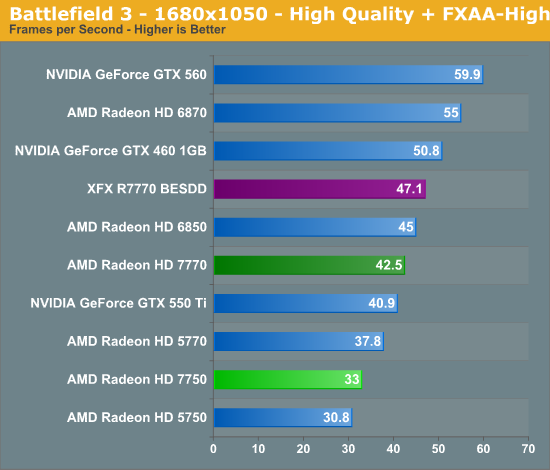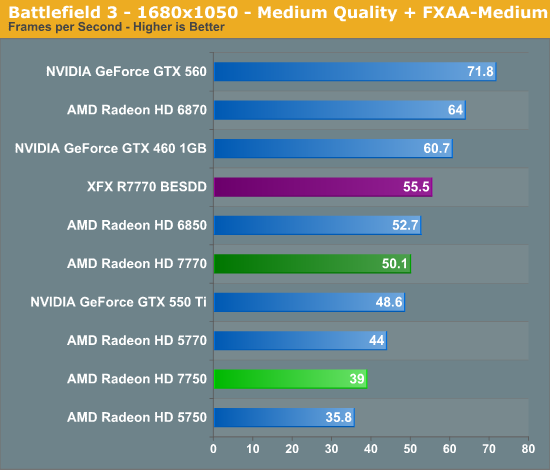AMD Radeon HD 7750 & Radeon HD 7770 GHz Edition Review: Evading The Price/Performance Curve
by Ryan Smith & Ganesh T S on February 15, 2012 12:01 AM EST- Posted in
- GPUs
- AMD
- HTPC
- GCN
- Radeon HD 7000
Battlefield 3
Editor’s Note: Earlier today DICE released a patch that among other things is supposed to improve Radeon HD 7000 series performance in the game. We’ll update our numbers to include revised benchmarks as soon as we can.
Its popularity aside, Battlefield 3 may be the most interesting game in our benchmark suite for a single reason: it’s the first AAA DX10+ game. It’s been 5 years since the launch of the first DX10 GPUs, and 3 whole process node shrinks later we’re finally to the point where games are using DX10’s functionality as a baseline rather than an addition. Not surprisingly BF3 is one of the best looking games in our suite, but as with past Battlefield games that beauty comes with a high performance cost



BF3 is an all-around GPU killer, which in the case of the 7700 series doesn’t help matters. Keeping in mind our benchmarks typically trend high, even at 1680 with Medium settings we’re not cracking 60fps with anything less than a GTX 460 1GB. In this case the 7770 should be playable, but intense firefights will definitely drop through the 30fps floor.
In any case the performance of the 7700 series is starting to show some consistency. Once again the 7770 underperforms the 6850, this time by 5%, elsewhere the 7750 noticeably trails the 5770. Nothing on the AMD side is anywhere close to the GTX 560 however.
Looking at our data, I’m a bit worried about the amount of VRAM the 7770 has. 1GB is already not quite enough for some games at 1920 with high quality settings, but BF3 is especially punishing. If we see more games like BF3, I have to wonder if 1GB will be enough for even 1680 in a year’s time.










155 Comments
View All Comments
Articuno - Wednesday, February 15, 2012 - link
Kepler really, really needs to come out soon, and I'm saying this as an AMD fan.Malih - Wednesday, February 15, 2012 - link
Exactly, I'm a fan of AMD myself, and I can't wait for Kepler, AMD needs a kick in the (you know what)DimeDeviL - Wednesday, February 15, 2012 - link
"Theoretically the 5770 has a 5% compute performance advantage over the 5770."eminus - Wednesday, February 15, 2012 - link
uhhh really? same card performs better hehehehetynopik - Wednesday, February 15, 2012 - link
lobbing off -> lopping offmattgmann - Wednesday, February 15, 2012 - link
I feel like reviewers were blinded by performance with the 7970/7950 cards. They offer the same lack of competitive pricing as these lower end cards. The 7950 can be compared directly (in price and performance) to the Nvidia GTX 580, a card that was available a year ago.I'm still rocking a pair of 4870s that set me back ~$400 a few years back. To get a substantial performance upgrade, I'd have to spend $450 on a 7950 today. Where is the value in that? Yes, power consumption and features are important but are tertiary to raw performance in almost every user scenario when it comes to gaming.
To say the least, the lack of competitive pricing between nvidia and amd currently smells a little fishy.....it wouldn't be the first time there was price fixing in the graphics card industry.
maniac5999 - Wednesday, February 15, 2012 - link
I'm convinced that the pricing for 4870s in late 2008/early 2009 was the sweet point to buy. Yes, power consumption sucks, but other than that, a card that cost me $160 then, is pretty competitive with a card that costs $120 today. I think we may have just lucked out with the 4870s, and may need to wait until at least Kepler, if not 8XXX to upgrade.chizow - Wednesday, February 15, 2012 - link
Just be careful not to set expectations on the 4870's pricing for 2 reasons:1) 4870 pricing was a mistake imo. AMD will say it was a calculated one in fluff pieces like the RV770 story and it was true in some degree that AMD needed to recover mindshare/marketshare and consumer confidence after the R600 debacle and a weak performing RV670. Still, when you set your single-GPU flagship at $300 and your second SKU at $200, there's not much room to go down on pricing.
2) Late 2008 early 2009 was the height of the recession. Wall Street, Real Estate, Auto Industry, all that. Nvidia and AMD were feeling it too and got involved in a highly publicized price war. That's why you saw "new" high-end performance parts like the 4890 and GTX 275 launching for $230-$250 that occupy the $350+ market today, with cards like the 4870 and GTX 260c216 selling at tremendous value for $150 or less.
Its obvious AMD is doing its best to correct their 4870 price mistake over the last few years, but with the overall performance of Southern Islands stack, the 7-series was the wrong time to do it. They should've just stuck to their old pricing scheme or at worst, matched Nvidia's pricing ($500, $380) with their Tahiti parts. Then you might see the rest of the stack priced reasonably.
Zoomer - Wednesday, February 15, 2012 - link
Yeah, at this point of the business cycle, it sucks to have to buy anything. Everything is expensive due to all the capacity cuts.Recessions are good (for buying things, cars, houses, whatever). Btw: Housing is an anomaly due to efforts to stop/slow the process.
Oxford Guy - Wednesday, February 15, 2012 - link
Recessions are good for the rich... not so good for everyone else.